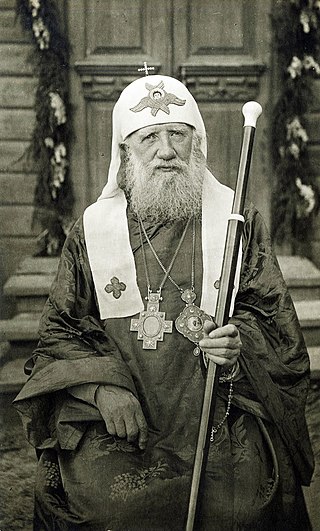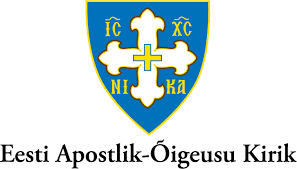
The Russian Orthodox Church, alternatively legally known as the Moscow Patriarchate, is an autocephalous Eastern Orthodox Christian church. It has 194 dioceses inside Russia. The primate of the ROC is the Patriarch of Moscow and all Rus'.

The Orthodox Church in America (OCA) is an Eastern Orthodox Christian church based in North America. While the OCA is in full communion with most Eastern Orthodox churches in the world, the OCA's autocephaly is not fully recognized. The OCA consists of more than 700 parishes, missions, communities, monasteries and institutions in the United States, Canada and Mexico. In 2011, it had an estimated 84,900 members in the United States.

Old Believers or Old Ritualists are Eastern Orthodox Christians who maintain the liturgical and ritual practices of the Russian Orthodox Church as they were before the reforms of Patriarch Nikon of Moscow between 1652 and 1666. Resisting the accommodation of Russian piety to the contemporary forms of Greek Orthodox worship, these Christians were anathematized, together with their ritual, in a Synod of 1666–67, producing a division in Eastern Europe between the Old Believers and those who followed the state church in its condemnation of the Old Rite. Russian speakers refer to the schism itself as raskol (раскол), etymologically indicating a "cleaving-apart".

Tikhon of Moscow, born Vasily Ivanovich Bellavin, was a bishop of the Russian Orthodox Church (ROC). On 5 November 1917 (OS) he was selected the 11th Patriarch of Moscow and All Russia, after a period of about 200 years of the Synodal rule in the ROC. He was canonised as a confessor by the ROC in 1989.
Lists of leaders of major religions in any given century include:

The Trinity Lavra of St. Sergius is a lavra and the most important Russian monastery, being the spiritual centre of the Russian Orthodox Church. The monastery is situated in the town of Sergiyev Posad, about 70 kilometres (43 mi) to the northeast from Moscow by the road leading to Yaroslavl, and currently is home to over 300 monks.

The Red Gate was a set of triumphal arches built in an exuberantly baroque design in Moscow. Gates and arches of this type were common in 18th century Moscow. However, the Red Gate was the only one that survived until the 20th century. It was demolished in 1927, but the name still survives in an eponymous Moscow Metro station.

The Estonian Apostolic Orthodox Church is an Orthodox church in Estonia under the direct jurisdiction of the Ecumenical Patriarch of Constantinople. Under Estonian law it is the legal successor to the pre–World War II Estonian Orthodox Church, which in 1940 had over 210,000 faithful, three bishops, 156 parishes, 131 priests, 19 deacons, two monasteries, and a theological seminary; the majority of the faithful were ethnic Estonians. Its official name is the Orthodox Church of Estonia.
A stauropegion, also spelled stavropegion, is a monastery or a parish which depends directly on the primate or on the Holy Synod of a particular Church, and which is not under the jurisdiction of the local bishop. The name comes from the Byzantine tradition of summoning the Patriarch to place a cross at the foundation of stauropegic monasteries or parochial churches.
Eastern Orthodoxy in North America represents adherents, religious communities, institutions and organizations of Eastern Orthodox Christianity in North America, including the United States, Canada, Mexico, Central America, and the Caribbean. Estimates of the number of Eastern Orthodox adherents in North America vary considerably depending on methodology and generally fall in range from 3 million to 6 million.

The Russian Orthodox Church is traditionally said to have been founded by Andrew the Apostle, who is thought to have visited Scythia and Greek colonies along the northern coast of the Black Sea. According to one of the legends, St. Andrew reached the future location of Kiev and foretold the foundation of a great Christian city. The spot where he reportedly erected a cross is now marked by St. Andrew's Cathedral.

The Estonian Orthodox Church of the Moscow Patriarchate is a semi-autonomous church in the canonical jurisdiction of the Patriarchate of Moscow whose primate is appointed by the Holy Synod of the latter.

Russian philosophy is a collective name for the philosophical heritage of Russian thinkers.

In AD 1453, the city of Constantinople, the capital and last stronghold of the Byzantine Empire, fell to the Ottoman Empire. By this time Egypt had been under Muslim control for some seven centuries. Jerusalem had been conquered by the Rashidun Caliphate Muslims in 638, won back by Rome in 1099 under the First Crusade and then reconquered by Saladin's forces during the siege of Jerusalem in 1187. Later in the seventh Crusade, it was taken back by the Catholics once again. It was conquered by the Ottomans in 1517. Orthodoxy, however, was very strong in Russia which had recently acquired an autocephalous status; and thus Moscow called itself the Third Rome, as the cultural heir of Constantinople. Under Ottoman rule, the Greek Orthodox Church acquired power as an autonomous millet. The ecumenical patriarch was the religious and administrative ruler of the entire "Greek Orthodox nation", which encompassed all the Eastern Orthodox subjects of the Empire.

The Patriarch of Moscow and all Rus', also known as the Patriarch of Moscow and all Russia, is the title of the primate of the Russian Orthodox Church. It is often preceded by the honorific "His Holiness". As the ordinary of the Diocese of Moscow, the office holder's direct canonical remit extends only to Moscow; however, as Patriarch, the office holder has a number of church-wide administrative powers as laid down by the charter of the Russian Orthodox Church.

Athanasius III Patellarios was the Patriarch of Constantinople in 1634, 1635 and 1652. Before his patriarchate Athanasius was metropolitan of Thessaloniki. He participated at Patriarch Nikon's book editing reforms in 1653.

Saint Sabbas Church is a Romanian Orthodox church located at 44 Costache Negri Street in Iași, Romania. It is dedicated to Saint Sabbas the Sanctified.














